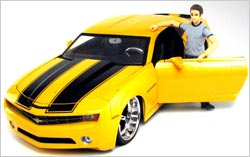 Someone pointed out to me
recently that the glasses I was wearing had a silver "CTS" logo on the temple section. I looked at the inside-facing part and saw "Cadillac" in the brand's script, which was hard to read because I
didn't have my glasses on. When this person -- a fellow IMPA (International Motor Press Association) member -- wondered aloud about the nature of licensed merchandise, I decided to get a 30,000-foot
view of GM's licensing program from Gene Reamer, manager of licensing and merchandising at the automaker.
Someone pointed out to me
recently that the glasses I was wearing had a silver "CTS" logo on the temple section. I looked at the inside-facing part and saw "Cadillac" in the brand's script, which was hard to read because I
didn't have my glasses on. When this person -- a fellow IMPA (International Motor Press Association) member -- wondered aloud about the nature of licensed merchandise, I decided to get a 30,000-foot
view of GM's licensing program from Gene Reamer, manager of licensing and merchandising at the automaker.
I asked him whether the point of such a program is to build consideration by
aligning GM brand names with cool products, or if it is intended to keep fans involved in their favorite GM vehicle or division. "The core is feeding our passionate consumers -- enthusiasts who have a
great affinity for our products," he says, adding that GM's muscle cars, Corvette and Camaro, are an obvious focus for branded merchandise.
advertisement
advertisement
But he adds that a lot of products -- from Chevy
caps to Chevrolet vehicles as rideable toys -- address a group of enthusiasts who like the Chevrolet bow tie and have had Chevrolet vehicles going back for generations. "So there's a strong emotional
attachment to the brand."
Reamer says about 80% of GM's licensed-merchandise business is mass market -- with toys, apparel, video games the major categories driven by retail in places
like Kmart and Walmart. Given that so much of the licensed gear is spun off from product integration in movie and entertainment platforms, it isn't surprising that the automaker moved its licensing
program under branded entertainment three years ago. "Chevrolet, for example, had a huge role in all three 'Transformers' movies," he notes, "So you have a lot of kids growing up who love the
Bumblebee character (a bright yellow Transformer/Camaro in the films); kids are activity-oriented, so that's the key, whether it's a simple plastic toy in primary colors, or friction-powered and
radio-controlled toys."
Reamer says that the work is also in virtual worlds, as the licensing practice at GM's branded entertainment section is also involved in getting vehicles and brands
into console and mobile games, and social media games like CarTown.
And, he says, the company doesn't base product placement in movies on the potential upside for merchandising.
While the company looks for merchandising opportunities with product placement, "it doesn't mean it will always be there." Independent of entertainment properties and product placement tie-ins, the
licensing group looks at non-automotive products and product categories for a non-traditional fit.
To that end, Reamer and his team go to conventions like the Licensing International Expo and
the Advanstar Fashion Group's Magic Show to try to find opportunities beyond die-cast and toys.
He says that when it comes to supporting a divisional brand or specific model, the bottom
line is equity. "The licensing business is equity driven," he says. "The strength, size and scope of a program is directly related to how much passion resides in the brand; without equity you have no
licensing program."